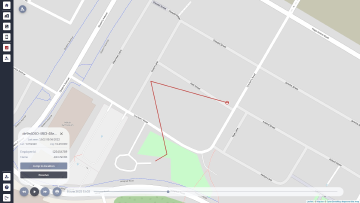Indoor Positioning Technology Review 2022

Introduction: Which is the best indoor positioning technology for mobile apps?
Our customers frequently ask us which indoor positioning technology is best for them. So we’ve tried to write an honest, unbiased article that answers this question.
There’s no single technology that is obviously the best. It really does depend on your particular requirements and environment.
For each technology, the costs need to be balanced against the delivered accuracy. For all the talk about ‘sub-meter accuracy’, it’s seldom required. For indoor navigation systems, an accuracy of a few meters is needed.
Recent advances in Indoor positioning
Since our 2021 update, there have been some significant announcements and developments. Here are the key changes to be aware of:
Aruba OpenLocate
Aruba announced that their latest APs support GPS. The main purpose of this is to attempt to auto-locate the positions of the APs (in latitude and longitude coordinates). Many, or perhaps most APs won’t get good GPS positions because they have a severely obscured view of the sky. But maybe a few APs near the periphery of buildings, e.g. by windows can get accurate GPS positions. Aruba claims that the positions of the other APs on the network can then be calculated using the accurate GPS positions and signals between APs (FTMs). However, currently there is no support for multi-floor environments which substantially reduces the usefulness of this auto-locate functionality in most real deployments.
Alongside the auto-locate feature Aruba also launched their “Open Locate” initiative. This is potentially more important to the location ecosystem. Once the locations of APs are known (either via the auto-locate feature or otherwise) Aruba’s networks make this information freely available. Mobile apps can therefore consume the positions of the APs directly and subsequently use this information to position the device. This potentially removes some of the setup configuration in some IPS systems.
Android 12
Google’s Android 12 release supports one-sided WiFi RTT. This relatively unknown capability is similar to the usual two-sided WiFi RTT protocol except the timing measurements are only taken on the device, instead of on the device and the AP. Since the AP is ‘uncooperative' in one-sided RTT this means that the technique can be used with legacy APs and APs that don’t support two-sided RTT. The market, however, will remain niche until Apple device’s support RTT and more people own the latest Android handsets. Initial findings suggest that one-sided WiFi RTT is less accurate than the two-sided version and gives accuracies of 3-5 m in ideal conditions.
For regular 2-sided RTT, the proportion of devices with support is growing, and is currently around 30% of Android users.
Apple IMDF
Lastly, Apple’s IMDF (indoor mapping data format) has been approved as a community standard by the Open Geospatial Consortium. This is relatively old news (Feb 2021) but illustrates another way in which the location ecosystem is slowly moving towards open standards. Open standards for mapping and positioning are required for faster development, integration and interoperability to enable mass adoption.
Bluetooth HADM
Last year we identified Dialog’s WiRa as an interesting technology to watch, but only if it was adopted as part of the Bluetooth specification. Now there’s a competing Bluetooth ranging technology from Broadcom: HADM.
2022 Comparison of Indoor Positioning Technologies and Indoor Positioning Solutions
There are broadly three types of information that drive indoor positioning systems (IPS). Fixed anchors, fingerprinting, and inertial.
Fixed Anchors
Fixed anchors are the direct replacement for GPS (Global Positioning System) in indoor environments.
Many systems rely on knowing the location of a transmitter or receiver. A signal between the fixed anchor and a mobile device can then tell us the distance, or angle between them. Once you know the distance or angle to multiple fixed anchors, you can determine the indoor position of the mobile device.
The transmitters or receivers have to be installed within a building as the signals used don’t have the range reach outside the building. In the future, it may well be possible to use a network of fixed anchors across a wide area for indoor positioning - like a ground-based GPS.
Signal Types
Very often a radio frequency signal is used, for example, Bluetooth, WiFi, or UWB. But there are systems that use ultrasound too.
Transmitter or Receiver
Sometimes the fixed anchor is the transmitter, and the signal is received by the mobile device. Examples are Bluetooth Low Energy (BLE) beacons and ultrasound beacons.
Sometimes the fixed anchor is the receiver, picking up signals transmitted by the mobile device. An example is the WiFi Indoor Location offered by Cisco and Aruba.
Signal Strength Range Measurement
Many systems measure distance by using the received signal strength (RSSI). This is always prone to considerable error. Indoor Positioning Systems based solely on RSSI will always be less accurate.
Bluetooth Beacons
Probably the most common example of signal strength positioning.
Installation is needed. But the beacons are low-cost and battery-powered, with battery life measured in years. So both installation and ongoing maintenance are minimal.
An increasing number of access points have Bluetooth radios in them, allowing access points to double as Bluetooth positioning beacons. This has the potential to significantly reduce the number of additional beacons that need to be installed.
Bluetooth is capable of longer range operation than many other technologies, which can be advantageous. Normal beacons have a range in the tens-of-meters. High power beacons using an RF amplifier stage can have a realistic range of 100m indoors. This means a smartphone can often see tens of beacons at the same time, providing a significant amount of information from which to try to determine accurate positions.
Bluetooth beacons alone don’t provide great accuracy. But when combined with inertial data, the accuracy is good enough for most use cases.
This technology is used by Crowd Connected.
WiFi
The great promise of WiFi positioning is that it leverages existing infrastructure.
However, iOS doesn’t give access to WiFi signal strengths. So positioning has to take place on the infrastructure, not the phone. And this means there’s no access to inertial information. This greatly limits the accuracy that WiFi signal strength positioning can achieve.
Another implication of carrying out positioning on the WiFI infrastructure is the addition of considerable latency. For use cases involving blue-dot navigation, we have heard from customers that the limited accuracy and high latency (lag) make the user experience poor.
If 802.11mc (RTT) or 8.2.11az reach mass adoption, this could all change. These technologies use time of flight ranging instead of signal strength, making them much more accurate. Inertial information is still helpful, but it’s not so important. So WiFi-based location may become a more attractive technology. For 2022, these technologies aren’t yet viable, mainly because iOS doesn’t support RTT.
Time of Flight Range Measurement
Much more accurate indoor positioning can be achieved if the distance between anchors and mobile devices is measured with precision. Technology options are increasing, and are starting to become available on smartphones. For instance, WiFi RTT times the signal rather than using signal strength, and is capable of sub-meter accuracy. It’s available now on Android phones.
WiFi RTT
WiFi RTT is looking more interesting as an indoor positioning technology in 2022, but it’s still not supported widely enough to achieve significant adoption.
On the phone side, it’s still only supported on Android, with no indications if and when Apple might support it. Apps using Crowd Connected’s SDK in Q1 and Q2 2022 have shown that around 30% of Android users have RTT capability. That’s around 10% of app users overall.
Looking at access points, RTT is now supported on all modern Aruba AP’s. Aruba account for around 14% of the global enterprise WiFi market.) But we’re still waiting for Cisco to support the standard. (Cisco hold around 40% of the global enterprise WiFi market.)
Crowd Connected has been scaling up testing of WiFi RTT positioning in larger real-world environments. There are some key technical difficulties that may limit performance, particularly in office buildings where walls limit the number of access points with line-of-sight visibility. The number of access points that can be successfully ranged is low. And the frequency at which ranges can be measured is low. Additionally many access points aren’t perfectly calibrated, so an offset may need to be applied to ranges, and this would have to be determined in a calibration phase.
One of the few vendors to have a product in the marketplace using WiFi RTT is Zebra. See their Best Practice Guide.
One Sided WiFi RTT
Android 12 quietly introduced an interesting new Indoor Positioning Technology - One-Sided WiFi RTT.
This technology is only currently applicable to a very small set of mobile devices - Android phones supporting Android 12.
However it works with any access point, not just those that have 802.11mc capability enabled in hardware and software. This is a huge advantage, opening up WiFi RTT to every WiFi installation globally, not just Aruba networks with modern access points.
The drawback of one-sided RTT is that the ranges to each access point are uncorrected for processing time. This means the distance measurements have a very large offset (often over 2km) that needs to be corrected. So generating reliable positions from one-sided RTT is complex, and would need either a thorough calibration step, or some complex on-the-fly optimisation techniques.
Initial findings suggest that one-sided WiFi RTT is less accurate than the two-sided version and gives accuracies of 3-5 m in ideal conditions.
See Indoor Localization Using Uncooperative Wi-Fi Access Points.
Accurate Bluetooth ranging
There are two technologies worth noting that could enable Bluetooth devices to measure distance to beacons much more accurately than using signal strengths (RSSI).
The first is Dialog’s WiRa technology. This is proprietary (not part of the Bluetooth specification), and requires the use of specific WiRa enabled RF chipsets. So it’s not coming to Android or iOS phones any time soon. But it is an interesting technology. It uses phase measurements rather than round trip timing, and is able to measure ranges accurately.
There’s also promise of a new upcoming ‘high-accuracy distance measurement’ extension to the Bluetooth specification, with involvement from Broadcom. This isn’t yet available, but if it becomes part of the Bluetooth standard, then it could end up being implemented on both Android and iOS phones, and could unlock real improvements in smartphone Indoor Positioning.
Ultrasound
Ultrasound is an interesting technology for Indoor Positioning. Measuring the distance from phone to beacon should be much more accurate than using Bluetooth signal strengths, because the signals travel slow enough for very accurate time of flight measurements.
Ultrasound beacons have been available for some time, but the technology hasn’t crossed over into mainstream adoption.
The most established vendor in the space is Sonitor.
Ultrawideband
The final time-of-flight technology worth mentioning is Ultrawideband (UWB).
In our previous update, UWB was an iOS-only technology. But it’s now supported by the latest Android phones from Samsung, as well as the latest iOS phones. So there is hope that over time it will reach a critical adoption level to be a viable indoor positioning technology.
UWB beacons have to be installed, in much the same way as Bluetooth beacons. The great advantage over using Bluetooth beacons would be the far greater ranging accuracy that is possible with time of flight measurements rather than signal strengths.
Crowd Connected has started testing UWB development boards in a test facility.
One of the few suppliers advertising beacons is Estimote. We haven’t tested these beacons yet. Their offering seems to deliver proximity context, not indoor positioning.
We have some concerns as to how well the technology will work in real-world deployments. In particular the beacon cost, battery life, range, frequency of range observations, and throughput (how many devices can simultaneously range to a single beacon) all need to be determined in realistic environments.
It’s very possible that when balancing these different factors for real-world deployments, the use of UWB beacons has little advantage over the use of current generation Bluetooth beacons.
Angle Measurement
Other technologies measure the angle from anchor to mobile device, rather than the distance. One example, Bluetooth 5.1 which supports AoA and AoD.
For smartphone positioning, Bluetooth 5.1 Angle of departure looks interesting. The fixed anchors (beacons) become more complex, involving an antenna array that broadcasts different signals in different directions. But the hardware at the phone end can remain simple, using a standard antenna.
In 2022 we haven’t yet seen a system capable of positioning iOS or Android phones using Bluetooth 5.1 Angle of Departure.
For asset tracking, Angle of Arrival is available. The asset needs only be tagged with a simple bluetooth transmitter. The receivers are installed, and house the complex antenna array.
Quuppa is the most established vendor in this space.
Fingerprinting
Fingerprinting is a completely different approach. Rather than knowing the exact location of fixed anchors, fingerprinting relies on mapping the signal fluctuations across the area to be covered. The signals may already exist in the environment (like the earth’s geomagnetic field, or WiFi signals from an existing installation). Or existing signals may be supplemented by installing additional transmitters like Bluetooth beacons, but without having to record their precise location.
The great advantage of fingerprinting is that it avoids installation and mapping of fixed anchors. However, there is considerable work in building and maintaining the fingerprint map in order to achieve the required accuracy.
And solutions are seldom completely free of infrastructure. Most solutions that work on both iOS and Android phones do still require the installation of at least some Bluetooth beacons.
Numerous vendors operate in this space, representative are Indoor Atlas and Polestar.
Inertial
The final source of data is inertial, from movement sensors on the mobile device.
It is possible to locate people just from these sensors (pedestrian dead reckoning). But you need to know their starting point and initial heading. And after a short time, the location data will drift off track.
So inertial data is most useful when combined with another technique (fixed anchors or fingerprinting) capable of absolute rather than relative positioning.
Future sources of location information
In the future, 5G may well enable better indoor location. For public 5G networks, we’ll have to wait and see whether and how the networks open up location data to third parties.
Satellite technologies are moving forwards too. Galileo has always promised better indoor performance than GPS, but we have yet to see any real-world tests. Low-earth orbit (LEO) positioning could also enhance indoor performance.
Summary of technologies
| Technology | Pros | Cons | Summary |
|---|---|---|---|
| Bluetooth Beacons Low cost battery powered Bluetooth Low Energy transmitters installed and mapped. Signal strength sensed by the mobile device. |
Installation is low cost and simple. Beacons are increasingly integrated into access points, light fittings etc. When combined with inertial data from smartphones, accuracy of 2-3m is possible. No fingerprinting or calibration is required. |
Sub-meter accuracy isn’t possible. Without inertial data, accuracy is more like 10m. | Tried and tested technology that delivers a balance between accuracy and cost. |
| Fingerprinting Multiple signals: Earth’s magnetic field, WiFi, Bluetooth |
Little or no infrastructure needed. Transmitters don’t need to be mapped. | WiFi fingerprinting isn’t possible on iPhones, meaning beacons are often required anyway. Overhead of creating and updating fingerprint maps. |
The holy grail of positioning with zero-infrastructure is enticing. But available solutions don’t yet deliver a robust enough product. |
| WiFi location based services | If you already have the WiFi network installed, there’s no additional hardware. Works across all smartphones. | Access points are often in the wrong places for optimal accuracy. And there are often insufficient access points for optimal accuracy. |
If zone level accuracy is required, can be a good solution. But for indoor navigation systems, the low accuracy and high latency seldom deliver. |
| WiFi 802.11mc (RTT) Measures location at the mobile device. |
By using time of flight, sub-meter accuracy is possible. | Supported on 30% of Android phones, but not by iPhones. Supported by some WiFi providers (eg Aruba), but not all. | One to watch. If and when Apple support 802.11mc, it will be a front-runner for any indoor environment that has enterprise WiFi. |
| One-sided RTT Measures location at the mobile device. |
By using time of flight, sub-meter accuracy is possible. | Supported only on Android 12. Works with any AP. | One to watch. For niche applications on Android only, could be an interesting alternative. |
| WiFi 802.11az (Next Generation Positioning) Detects device location at the access point. |
By using time of flight, sub-meter accuracy is possible. | Not yet part of the WiFi standard. | One to watch. May end up leap-frogging 802.11mc to become the leading WiFi location technology. |
| UWB (Ultrawideband) Short range wireless, a competitor to Bluetooth Low Energy (BLE). |
By using time of flight, sub-meter accuracy is possible. | Supported only by the iPhone 11 and above, and high end Android devices. UWB chips are more expensive that Bluetooth, but prices appear to be coming down. |
Could be a great solution. But only if smartphone support increases, and prices continue to fall. |
| Ultrasound Beacons | By using time of flight, sub-meter accuracy is possible. | Ultrasound beacons are more expensive than Bluetooth beacons. Technology is not yet widely adopted or proven. | An interesting option that deserves consideration. |
| Bluetooth-based WiRa / HADM | By using time of flight, sub-meter accuracy is possible. | New technology - competing standards from Dialog and Broadcom. Not yet supported by phones, or adopted into the Bluetooth specification. | Might be interesting if it becomes part of the Bluetooth standard. |
| Bluetooth Angle of Arrival / Departure | By using accuracy angle measurement, sub-meter accuracy may be possible. | Expensive beacons with multiple antennas need to be carefully installed, making the system more expensive. | Current solutions are quite specialist (high performance, but also higher cost). |
| Inertial | Doesn’t require any signals at all - so works anywhere. | Needs a known starting position and heading, and quickly drifts off track | Very valuable when combined with one of the other technologies. But doesn’t deliver on its own. |
Crowd Connected's Sail technology uses Bluetooth beacons and inertial data. Combining both inputs results in positioning accuracy of around 2 to 5 meters. No fingerprinting is involved. Sail is already compatible with WiFi 802.11mc, and if iOS supports this technology in the future, Bluetooth beacons may no longer be required.


